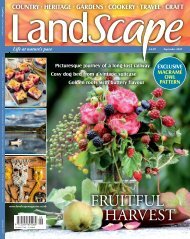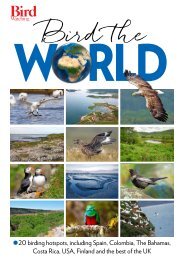You also want an ePaper? Increase the reach of your titles
YUMPU automatically turns print PDFs into web optimized ePapers that Google loves.
NATURE’S ARMY OF<br />
STRIPED HELPERS<br />
Considered a nuisance when gatecrashing picnics, the Common wasp<br />
plays an important role by feeding on crop-harming pests<br />
IT IS A hot, muggy summer day, and<br />
with a high-pressure system poised over<br />
the country, the weather is likely to stay<br />
fine for the next few days: perfect for<br />
picnics and barbecues.<br />
With birdsong now more or less over<br />
for the season, insects are the main<br />
summer soundtrack. Bumblebees buzz<br />
purposefully along the edges of fields in<br />
search of nectar; grasshoppers and crickets<br />
chirp their high-pitched songs from the<br />
long grass; and Meadow Brown and<br />
Gatekeeper butterflies are on the wing.<br />
But another, less welcome, yet no less<br />
important, insect is also out and about: the<br />
Common wasp, Vespula vulgaris. As the<br />
sun rises in the clear blue <strong>July</strong> sky, they<br />
emerge from their nest and begin to forage<br />
for food. And suddenly, outdoor dining<br />
does not seem such a good idea after all.<br />
Wasps are attracted to sweetness, and<br />
cakes, fizzy drinks, relishes and ketchup all<br />
act as a magnet for these striped creatures.<br />
They have a very acute sense of smell and<br />
can detect sugars, whether natural, such as<br />
nectar, or man-made, as with our food and<br />
drink, and then home in on the source.<br />
Thousands of wasps<br />
There is not just one kind of ‘wasp’: there<br />
are more than 7,000 different species living<br />
in the UK alone, which is more than there<br />
are species of mammal on the planet, and<br />
“Lord, clear my misted sight that I<br />
May hence view Thy divinity,<br />
Some sparks whereof thou up dost hasp<br />
Within this little downy wasp”<br />
there are more than 100,000 species of<br />
wasp worldwide. The definition of a ‘wasp’<br />
is, however, rather vague: any insect in the<br />
order Hymenoptera that is neither a bee<br />
nor an ant.<br />
Britain’s wasps range from tiny<br />
creatures, just a few millimetres long, to<br />
the hornet, which can reach a length of<br />
more than 1in (28mm). Globally, the<br />
largest wasp is the Asian Giant hornet,<br />
Vespa mandarinia, with a length of more<br />
than 2in (5cm), although another species,<br />
the Giant Scoliid wasp of Indonesia, ›<br />
A natural nest built<br />
onto a fennel plant,<br />
which is a favourite<br />
of wasps. The nests<br />
start from the size<br />
of a walnut and can<br />
grow as big as a<br />
football.<br />
Edward Taylor, ‘Upon a Wasp Chilled with Cold’<br />
117

















